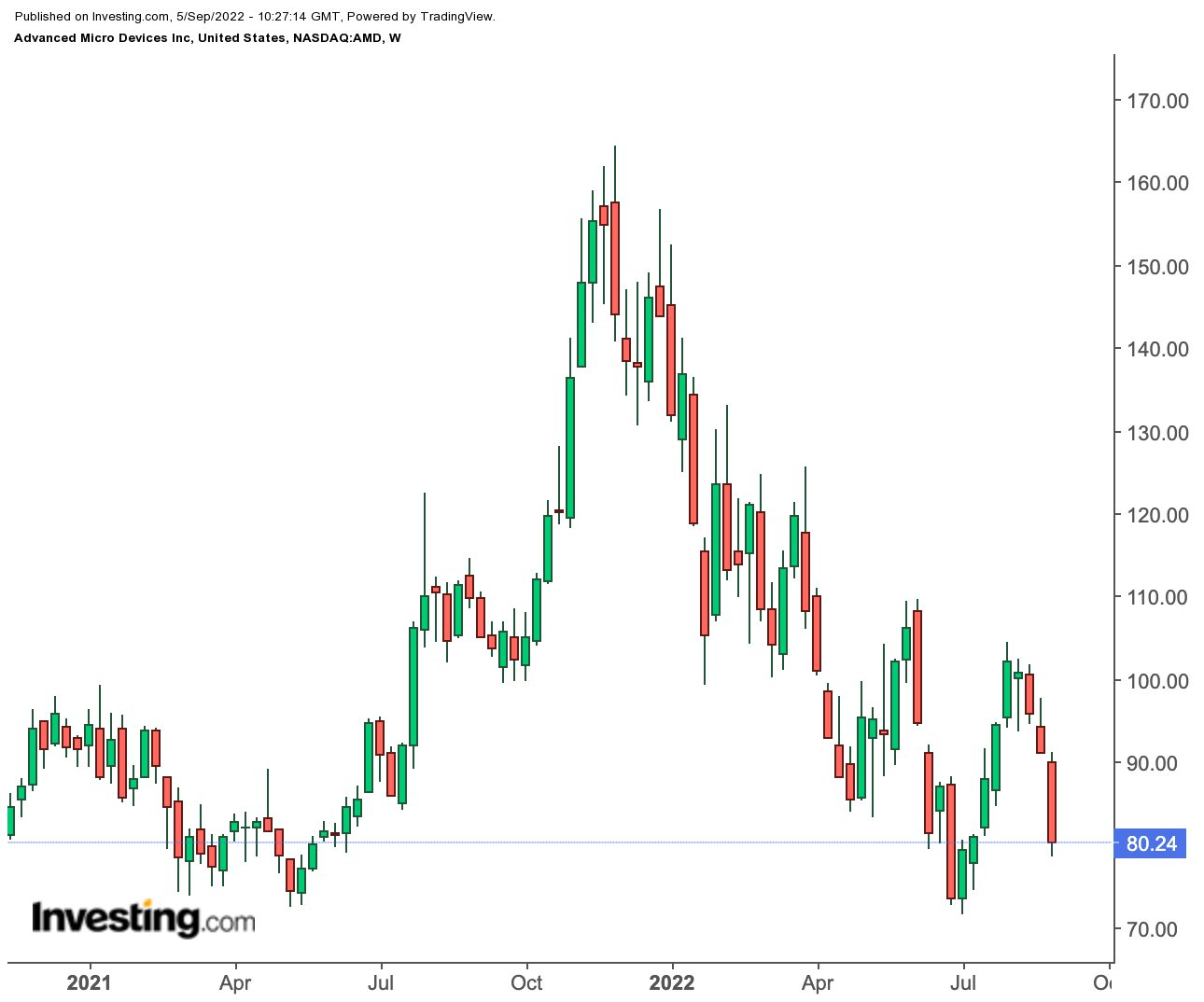- History shows that volatility in AMD stock is no surprise
- Recent developments have spooked investors
- But a rebound seems likely
On Nov. 29 of last year, Advanced Micro Devices (NASDAQ:AMD) stock set an all-time closing high of $161.91. Since then, shares have lost more than half of their value.
That fact alone doesn’t make AMD a buy here. The stock has seen a great deal of volatility during its history, though admittedly not usually at quite this speed. Investor sentiment toward the semiconductor sector and the market as a whole has weakened—for reasons that have some logic. Shares are cheaper, but not necessarily cheap in the context of the sector.
But at this lower price, AMD stock does look exceptionally attractive. This is a company that has executed an incredible turnaround. 2022 growth should be impressive. The long-term outlook remains intact. As long as investors trust management—and they should—AMD stock is too cheap.
A Long-Running Roller-Coaster
Advanced Micro Devices went public almost 50 years ago, raising $7.5 million through the sale of shares at $0.57 (adjusted for stock splits since). Over that stretch, AMD has returned 10% on an annualized basis—but the gains have been anything but consistent.
In the 1980s, for instance, AMD went from under $4 to over $20, only to close the decade back below $4. Shares roared during the dot-com boom; only to collapse. They roared again during the mid-2000s bull market, peaking at $42 in 2006. By the lows of the 2009 bear market, they were below $2.
A rally from those lows faded. In 2013, AMD was removed from the S&P 500 index because its market capitalization was too low. By early 2016, the stock was below $2—and bankruptcy was a legitimate possibility.
AMD was a weak rival to Intel (NASDAQ:INTC), which dominated the personal computer market. But PC sales were at risk of decline amid smartphone adoption. AMD closed 2015 with $2.26 billion in debt—and that year posted an adjusted operating loss of $253 million, with revenue plunging 28% year-over-year. Adjusted gross margins were just 28%.
But AMD had named Lisa Su chief executive officer in late 2014, and Su would oversee an incredible turnaround. The launch of Ryzen and EPYC chips made AMD a legitimate rival to Intel. AMD returned to the S&P 500 in 2017; it was the best-performing stock in the index in both 2018 and 2019. At last year’s peak, AMD had gained nearly 100x from February 2016 lows.
AMD Tumbles
In other words, volatility is part of the AMD package. In some cases, the big declines have made some sense. The fears that drove investors to sell the stock in the first half of the 2010s, for instance, were real. PC sales did stagnate. AMD was far behind Intel (and so was Globalfoundries, the company actually producing the chips).
This time around, there are risks. Semiconductors are a notoriously cyclical business (another reason for the historical volatility in AMD), and it’s possible a cyclical downturn is on the way.
For years, demand in end markets like gaming, automotive, data centers, and even PCs may well have been higher than usual. AMD’s impressive growth to some extent has been driven by that elevated demand; if demand weakens, so will AMD results.
Last week, investors were again spooked by an earnings miss from rival NVIDIA (NASDAQ:NVDA). Then, both NVIDIA and AMD disclosed that the U.S government had placed restrictions on the companies’ artificial intelligence chips.
AMD dropped another 12% for the week. The stock’s history alone shows why investors might be nervous that the declines will continue.
A Better Company
But the bull case for AMD is simple: this is not the company it once was. Again, just six years ago AMD was heavily reliant on personal computers—and on being the lower-cost, lower-performance option in that market.
That’s no longer the case at all. It’s Intel that now is scuffling along, repeatedly delaying multiple products. EPYC moved AMD into the fast-growing data center market; the purchase of Pensando buttressed its capabilities. The $50 billion acquisition of Xilinx, the biggest ever in the industry, further broadened AMD’s reach.
AMD now plays in multiple end markets, including many of the fastest-growing. At the Financial Analyst Day this summer, AMD said it now has a total addressable market of roughly $300 billion. The company expects revenue this year of roughly $26 billion, suggesting a long runway for growth—particularly if AMD can keep taking share from Intel.
At its core, the bull case for AMD stock is that the company will do precisely that. Under Su, the company certainly has earned that trust. And the numbers show why.
Again, in 2015 AMD had an adjusted gross margin of 28%. Customers weren’t willing to pay any kind of premium for the company’s products.
In the first two quarters of this year, adjusted gross margin was 53%. AMD believes it can get the figure to 57% or better over time — double the 2015 level.
This simply is a much, much better company. That in turn means that volatility should be seen very differently. In the past, when AMD turned south, it was a sign of trouble ahead. Now, it seems much more like an opportunity.
Disclaimer: As of this writing, Vince Martin has no positions in any securities mentioned.
